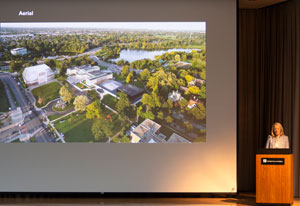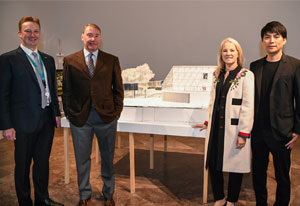I have always loved creating – from childhood art projects to needlepoint and later gardens and home decor. As an attorney, early in my career, I worked to empower foreign nationals to grow their businesses in America, customizing each case to ensure success. My initial community leadership entailed evolving traditional independent school models to more flexible and inclusive ones. And now, I’m inspired to continue to create and work to make transformative change in my community and beyond.
 |
 |
|
| Alice Jacobs announcing plans for the ambitious AK360 Campus Development and Expansion Project | ||
CREATIVITY
New thinking, new ideas, new collaborations. More than ever, these are needed to solve today’s increasingly complex social and cultural problems.
Non-profits are traditionally subject to environmental pressures of goal setting. The focus is on fundraising results, building and retaining a donor pool, and achieving short-term demonstrable program impact. The world is guided by the principle that donors expect and deserve an economically efficient and immediate result in exchange for their donation.
This leaves little room for creativity and innovation which require time to try different approaches, the ability to adjust as the process unfolds, and the freedom to measure program effectiveness in varying ways to define success. If donors better understood that their donations could go further with an altered approach, it is no doubt they would support these efforts.
LEADERSHIP
Not all new efforts will work. That is the nature of innovation, it does not come easy.
Boards have a lot to consider when carrying out their fiduciary duties. Today’s emphasis on accountability through impact, expected by donors and management as the measure for success, results in two forces that are contrary to the creative process: (1) pressure to meet set financial goals, and (2) pressure to ensure that programmatic initiatives demonstrate a successful impact within a reasonable period of time.
Innovation takes risk.
Shifting the non-profit culture towards the unknown takes work, but it is worthwhile. Strong leadership can educate boards and donors to be comfortable and confident with risk in order to focus less on short-term successes and more on the need to create space for creativity, exploring ideas, and the necessary room for failure.
INNOVATION PHILANTHROPY
We are responsible for how we preserve and further our culture and community. Let’s focus our philanthropic time, energy, and resources on making the best possible outcomes for our future.
While working and leading in the non-profit field, I’ve been inspired and challenged to solve daily administrative problems to large scale monumental issues. With it, I have developed the concept Innovation Philanthropy to re-center my decision-making. I hope you will join me and encourage others to learn more about how you too can be an Innovation Philanthropist.